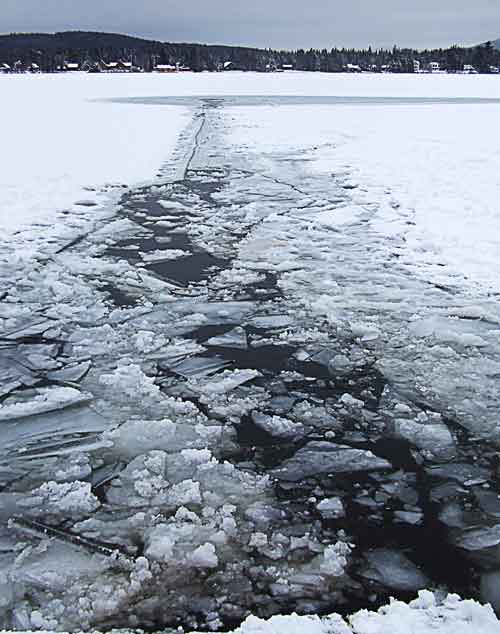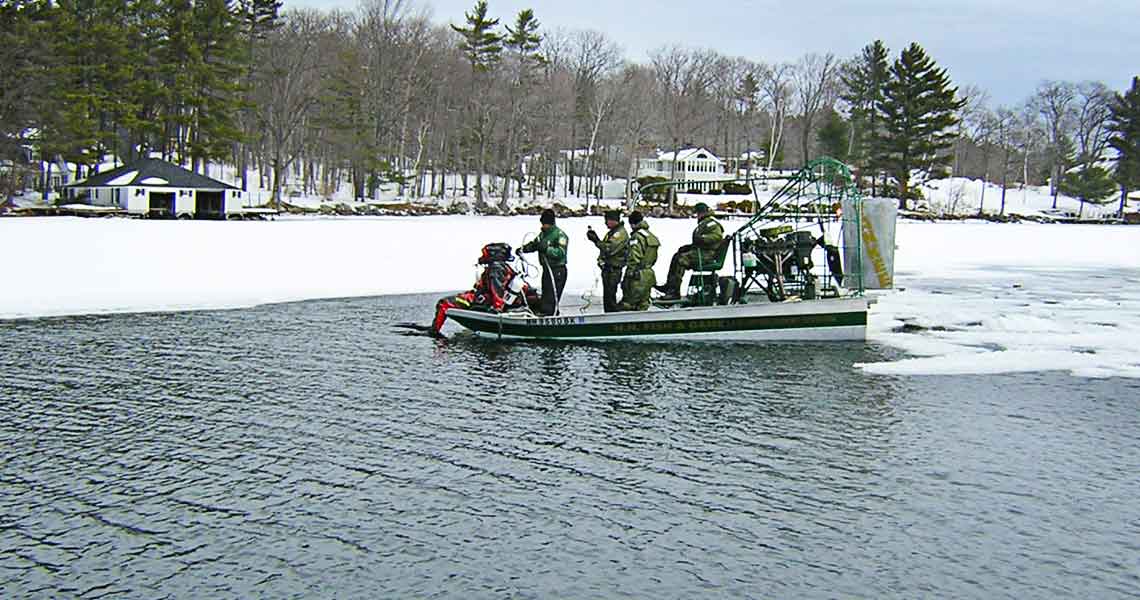Back on February 11, 2017, I was enjoying a father-daughter dance with my daughter. It was a great night and she was having a blast with her friends, and every now and then a dance with me. At the end of the evening, while waiting for our ride home, I took a few moments to check my email and look at the news on my phone. Boy did a great night come to a crashing halt.
Snowmobiles Through Lake Winnipesaukee
My email box was quiet, but the news was not. I found a spot in the hallway (a task that was not easy with 100+ young women running around) and called Colonel Kevin Jordan. I spoke with him for a few moments and learned that as of 6:00 p.m., a total of five snowmobiles had gone through the ice on Lake Winnipesaukee and many other accidents had occurred, both on and off the ice.
This weekend was the annual ice fishing derby sponsored by the Meredith Rotary Club. A group of three friends had gone through the ice in Moultonborough, and two of them died. In Alton, a father and son riding snowmobiles together went through the ice and the son was killed. Two weeks earlier, a young man on Boundary Pond in Pittsburg had passed away after hitting the bank of the lake. In a two week period, four riders had died – half the total fatal snowmobile accidents reported over the 2016/2017 season.
Frozen Bodies of Water Potentially Dangerous
These grim statistics are an important reminder of why New Hampshire Fish and Game advises so consistently that all frozen bodies of water are to be considered potentially dangerous. Ice does not form uniformly over the entire surface of a water body, and ice thickness at one location should not be considered to be indicative of ice thickness over a whole water body or geographic region. Individuals who are not personally familiar with the ice conditions should systematically and safely check the ice thickness before undertaking any activity on the ice.
Under RSAs 215-A and 215-C, which are the state laws that govern OHRVs and snowmobiles, there are no weight or size restrictions for frozen bodies of water. Also, there are no speed limits, with the exception of Back Lake in Pittsburg at night and Turtle Town Pond in Concord. But, as I mentioned above, as ice does not form evenly. On the fateful day last February, a steady light snow had covered the lakes. The ice looked the same in all locations. The three friends who went into the water in Moultonborough were on an annual weekend snowmobile ride and heading over to check the board at Meredith Bay. The father and son who went into the water in Alton were up enjoying the fishing derby.
Everyone Affected by Ice Conditions

Fish and Game Conservation Officers are affected by ice conditions, just like everyone else. We have had everything from a pick-up truck to ATVs go into the drink. When people are on the ice fishing, riding, or playing hockey, the Conservation Officers are out there as well, engaging with them.
A few years ago, a Conservation Officer’s sled went through the ice on Lake Winnipesaukee. In trying to get the sled out, a CO broke his leg. The following year, a CO riding on a lake hit an ice dam and was thrown many yards before hitting the ice and injuring his shoulder. We face the same issues as the everyday snowmobiler does.
What can we as riders do?
First, if at all possible, avoid the lakes and ponds when snowmobiling. I know this is not possible in many cases due to the trail system, but it’s something to keep in mind.
Second, all of our Conservation Officers are required to wear a float coat when going onto the frozen waters. Many snowmobile coat makers are now making float coats. They are a little more money, but what is the cost of a life?
Third, along with the float coats, the Conservation Officers must also have a set of ice picks with them in case they fall through the ice, which is a good idea for all snowmobilers.
Lastly, before you head out, call a local snowmobile club or a fishing bait shop and ask if they know how thick the ice is. Bait shops know this from the ice fishermen and women who are drilling. We here at Fish and Game do not check ice conditions nor give out this kind of information.
Please enjoy the winter wonderland of New Hampshire, but always use caution and plan for the worst. Having the right safety clothing and equipment could save your life or someone else’s.
Going home to your loved ones wet and cold is better than the alternative. Ride safe!
The Cold Facts of Snowmobile Ice Safety:
All frozen bodies of water are to be considered potentially dangerous.
Ice does not form uniformly over the entire surface of a water body and ice thickness at one location should not be considered to be indicative of ice thickness over a whole water body or geographic region.
Individuals who are not personally familiar with the ice conditions should systematically and safely check the ice thickness before undertaking any activity on the ice.
There are many factors that can affect ice thickness and strength (i.e. water currents, daily temperatures, snow cover, water depth, size of the water body, springs, wind action).
The Department has not conducted any research concerning ice thickness and its abilities to safely support various types of activities. However, according to information from the Cold Regions Research Laboratory in Hanover NH, new clear ice:
- 4 to 6 inches can support a few well-dispersed people
- 8 to 10 inches can support OHRV and snowmobile activity
Motor vehicles (cars and trucks) should not be driven onto any frozen body of water.
Dennis A. Etchells, Jr, New Hampshire Fish and Game Department, OHRV/Snowmobile Program Assistant

You must be logged in to post a comment.